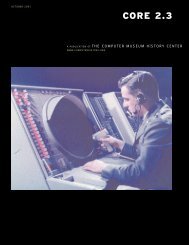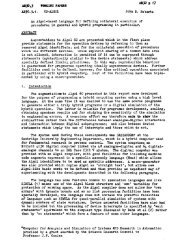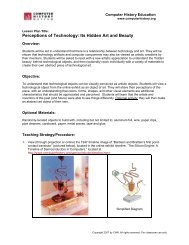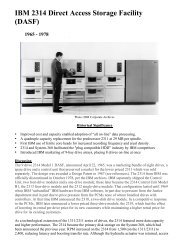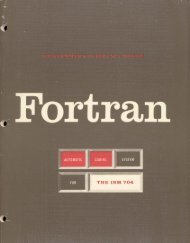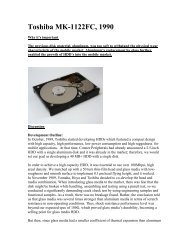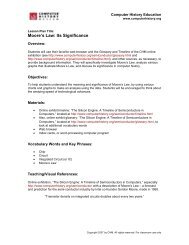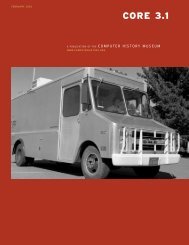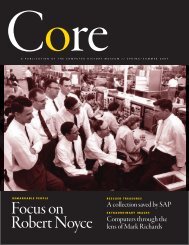SDS 900 series, 1965 ca.
SDS 900 series, 1965 ca.
SDS 900 series, 1965 ca.
You also want an ePaper? Increase the reach of your titles
YUMPU automatically turns print PDFs into web optimized ePapers that Google loves.
J ~ I ' " ' I\ ( , .:.... ' I, •, ~, 't, . . ." ~SOS SYSTEMS< ,~ I' , :. l' .. ,,~... ~ '. ," ~ J" • ".,0TYPICAL <strong>900</strong> SERIESAPPLICATION AREASAIRCRAFT AND MISSILE DESIGN AND ANALYSISDATA REDUCTION SYSTEMSThe <strong>SDS</strong> 920 is a low cost, general purpose computer designed for scientificengineering computation and for systems integration. It has allthe speed and operating features found only in much more expensiveequipment, including instructions that facilitate floating-point and multiprecisionoperations. An evaluation of the 920's unequalled performance-per-dollar<strong>ca</strong>pabilities <strong>ca</strong>n be made by comparing the followingcharacteristics with any presently available digital computer:TYPE: Single address with indexing and indirect addressing • Binary •Core Memory • Solid State • Instructions for facilitating floating-pointand multi-precision operations. Parity checking on Input/Output andMemory Operations • Programmed OperatorMEMORY: Coincident magnetic core • 4096 words expandable to 16,-384 words-all directly addressable. 24-bit word and parity. Nonvolatileif power failsEXECUTION TIMES: All times include both memory access & indexingAdd .. . .............. . ............. .... .... , 16 microsecondsMutiply ................. .. . ... .......... . . . , 32 microsecondsFloating-Point Operations:(24-bit Mantissa plus 9-bit Exponent)Add .. . . .......... . .... ... . ... . . .. . . ... . 292 microsecondsMultiply .. .. . . . . . ....... . ... ......... . . . 248 microseconds(39-bit Mantissa plus 9-bit Exponent)Add ......... . .. . ... . ......... . . . . . . .... 368 microsecondsMultiply ... . .. . .................. . ... . .. 600 microsecondsINPUT/ OUTPUT:Standard. Equipment - Five input/ output operation modes . Bufferwith input/output rates in excess of 50,000 characters/ second simultaneouswith computation • Dual channel priority interrupt • Displayconsole and manual control of internal registers. 300 character/ secondphotoelectric paper tape reader. 60 character/second paper tapepunch . Automatic input/ output typewriterOptional Equipment - 15 kc and 41.7 kc magnetic tape units (IBMcompatible) • 300 line/ minute printer. 200 cpm and 250 cpm <strong>ca</strong>rdreaders. Graph plotter. 896 channels of priority interrupt. Secondinput/output buffer. Direct communi<strong>ca</strong>tion with IBM 7090 • Analogto-digitalconverters. Paper tape spooler (shown above)PROGRAM MING: FORTRAN II with magnetic tape statements.Symbolic Assembler • Complete package of subroutines and utilityprograms • Program interchangeability with SOS 910 ComputerPHYSICAL: All silicon solid state components . Dimensions - 66"x 48"x 27" • Power - 11 OY , 60cps, 20 amps. Operating temperature range O°C. to +50°C.CIVIL ENGINEERINGSIMULATION STUDIESOPTICAL DESIGNAUTOMATIC CH ECKOUT SYSTEMSELECTRICAL DISTRIBUTION ANALYSISON-LIN E PROCESS CONTROLRANGE SAFETYSTATISTICAL ANALYSISRADAR CONTROL SYSTEMSTHERMODYNAMIC DESIGNSEARCHING THEORY AND ANALYSISCRYSTALOGRAPHIC STUDIESREACTOR DESIGN AND SIMULATIONTRAJECTORY COMPUTATIONSDATA ACQUISITION SYSTEMSQUALITY CONTROL ANALYSISMEDICAL RESEARCHMANUFACTURING CONTROL SYSTEMSSTRUCTURAL ANALYSISINFORMATION PROCESSINGNAVIGATIONCRITICAL PATH SCHEDULINGHYDRAULIC AND GAS NETWORK ANALYSISSATELLITE COMPUTER OPERATIONCOMMUNICATION SWITCHING SYSTEMSTELEMETRY DATA REDUCTIONThe SOS 910 is designed for low cost, high performance, general purposecomputing. Although its primary purpose is on-line control andreal time systems work, the 910 is useful as a general purpose scientificcomputer. The 910 is the first and only random access machine withbuffered input/output to be priced below $90,000. It operates directlywith all types of input/ output devices, including magnetic tape units,automatic typewriters, and analog-to-digital converters.TYPE: Single address with indexing and indirect addressing • Binary •Core Memory • Solid State • Parity checking on Input/Output andMemory Operations • Programmed OperatorMEMORY: Coincident magnetic core . 2048 words expandable to 16,384 words - all directly addressable . 24-bit word and parity. Nonvolatileif power failsEXECUTION TIMES: All times include both memory access & indexingAdd . . . . . . . . . . . . . . . . . . . . . . . . . . . . . . . . . . . . . . .. 16 microsecondsMultiply . . ..... .. .. . .. .. . . .. . . .. .... ....... . 248 microsecondsF loating Point Operations:(24-bit Mantissa plus 9-bit Exponent)Add ..... .. .. . . . ......... . ............. .440 microsecondsMultiply .. . . ... ... .... . . . . ...... . . .. ... . 504 microseconds(39-bit Mantissa plus 9-bit Exponent)Add . . . . . . ...... . .. . .. . .. . .... . .. . . ... , 832 microsecondsMUltiply ... . ......... . .. . . .. ......... . . 1696 microsecondsINPUT/ OUTPUT:Standard Equipment - Five input/output operation modes . Bufferwith input/output rates in excess of 50,000 characters/ second simultaneouswith computation. Dual channel priority interrupt. Displayconsole and manual control of internal registers . 300 character/ secondphotoelectric paper tape readerOptional Equipment - 60 character/second paper tape punch. Automaticinput/output typewriter. 15 kc and 41.7 kc magnetic tape units(IBM compatible) • 300 line/ minute printer. 200 cpm and 250 cpm<strong>ca</strong>rd readers • Graph plotter • 896 channels of priority interrupt •Second input/output buffer. Direct communi<strong>ca</strong>tion with IBM 7090 •Analog-to-digital converters. Paper tape spoolerPROGRAM MING: FORTRAN II with magnetic tape stateme nts .Symbolic Assembler • Complete package of subroutines and utilityprograms. Program interchangeability with SOS 920 computerPHYSICAL: All silicon solid state components. Dimensions - 75"x 24"x 27". Power - liOY, 60cps, 17 amps. Operating temperature range -O°C. to +50°C.



